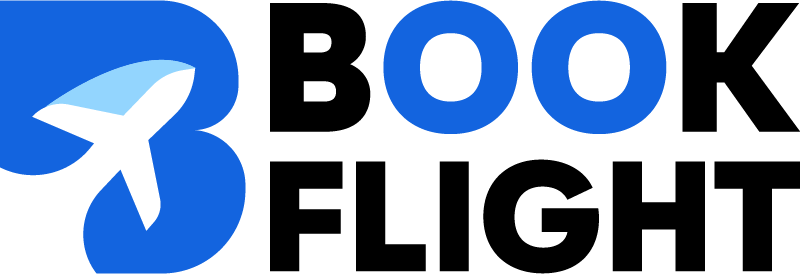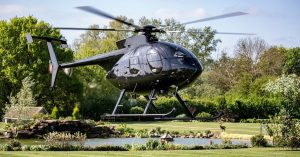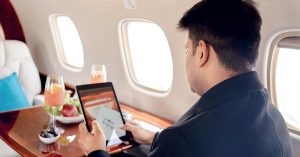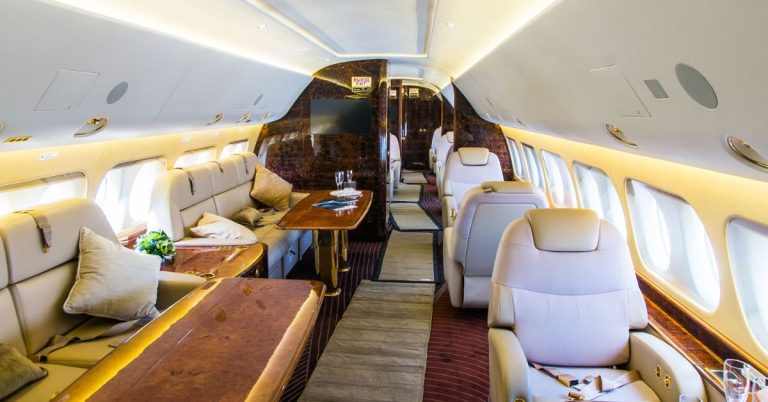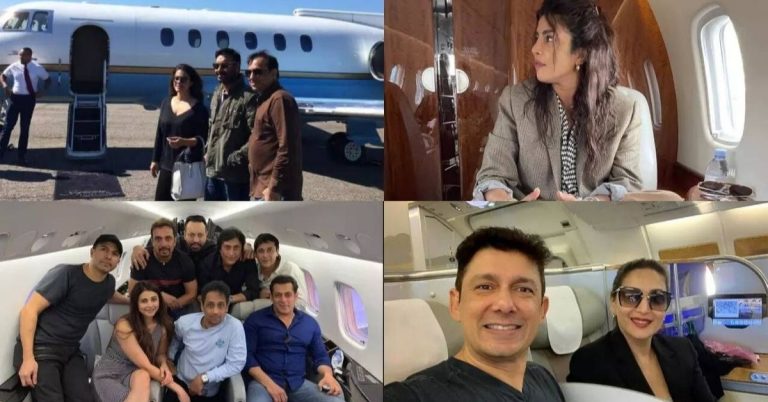Picture this: It’s early morning in New York City. You finish breakfast, head to the private terminal at Teterboro Airport, and by mid-afternoon, you’re sipping espresso in Milan. No TSA lines, no boarding chaos, no layovers. Just you, your jet, and the freedom to move at speeds that redefine travel.
This is the promise of private aviation—and at the heart of that promise is speed. Not just the ability to go fast, but to go fast on your terms. Whether you’re a CEO flying to close a deal, a family seeking seamless vacation travel, or a medical team on an emergency mission, how fast a private jet flies isn’t just a number—it’s a competitive edge, a time-saver, and in many cases, a life-enhancer.
After decades in the private aviation industry, I’ve seen firsthand how time saved in the air translates to opportunities gained on the ground. But how fast do private jets actually fly? And what factors influence their performance? That’s what we’re diving into.
In this article, we’ll unpack the true speed of private jets—from light jets cruising over coastal routes to ultra-long-range aircraft crossing continents in record time. We’ll talk numbers, compare categories, and explore the fastest jets in the sky today. You’ll gain a better understanding of what makes private aviation so powerful—and why speed, while impressive, is just one part of the experience.
So whether you’re considering a charter, shopping for your first jet, or just curious about what makes these aircraft tick—this guide will help you navigate the skies with clarity, confidence, and a touch of jet-set inspiration.
How fast do Private Jets Fly?
When we talk about how fast private jets fly, it’s easy to get lost in a mix of numbers and units. Knots, miles per hour, Mach—what do they all mean, and why does aviation seem to use them interchangeably?
Let’s break it down.
Knots: The Aviation Standard
In aviation, knots are the standard unit of speed. One knot equals 1.15 miles per hour, or more precisely, one nautical mile per hour. Nautical miles are used because they align better with the curvature of the Earth, making them ideal for global navigation. So when a pilot says a jet is cruising at 450 knots, they’re really talking about approximately 518 mph.
For pilots and air traffic control, knots offer precision and global consistency. For passengers, it often helps to convert those figures into miles per hour for a more intuitive understanding.
Miles Per Hour (MPH): The Familiar Benchmark
For most people outside aviation, MPH is the go-to unit. When you hear that a private jet flies at 575 mph, you get a clear picture of just how fast that is—especially compared to the speed of a commercial car or train. Most jet brochures and charter services will include both knots and mph to keep things clear.
Mach Speed: Near the Sound Barrier
Then there’s Mach speed, which measures how fast an object travels relative to the speed of sound. At cruising altitudes, the speed of sound is roughly 767 mph, but it varies depending on altitude and air temperature.
- Mach 0.80 means the jet is flying at 80% of the speed of sound.
- A jet cruising at Mach 0.90 is moving at about 690 mph.
Private jets like the Gulfstream G700, Bombardier Global 8000, and Cessna Citation X+ often operate at these high subsonic speeds, brushing up against the edges of what’s physically possible without crossing into supersonic territory.
Why the Mix of Units?
The aviation industry is deeply international and highly regulated. Knots make it easier to coordinate flights across countries and oceans. But when discussing performance with clients or media, manufacturers and brokers often use mph or Mach for impact and clarity.
Understanding these units doesn’t just help you grasp how fast private jets fly—it gives you a clearer picture of what you’re paying for, planning around, or investing in. Because at the end of the day, speed is more than a number. It’s a metric of time saved, goals reached, and expectations exceeded.

The Speed Spectrum of Private Jets
Not all private jets are built the same—and when it comes to speed, the differences can be significant. From nimble light jets designed for short regional hops to ultra-long-range titans that cross oceans without blinking, each category of private aircraft has a speed profile shaped by its mission.
Let’s take a closer look at how fast different types of private jets fly.
Light Jets: Agile and Efficient
Typical Cruise Speed: 400–470 knots (460–540 mph)
Light jets are the workhorses of short- to mid-range private travel. They’re ideal for trips under three hours, especially on domestic or regional routes. What they lack in top speed, they make up for in convenience, affordability, and accessibility to smaller airports.
Examples:
- Cessna Citation CJ3+: ~416 knots (478 mph)
- Embraer Phenom 300E: ~464 knots (534 mph)
If you’re flying from Dallas to Denver or London to Geneva, a light jet gets you there efficiently—with a comfortable cabin and fast boarding turnaround.
Midsize and Super-Midsize Jets: The Business Sweet Spot
Typical Cruise Speed: 460–500 knots (530–575 mph)
These jets offer the perfect balance between speed, range, and cabin size—making them a favorite among executives and growing charter clients. They can easily handle coast-to-coast U.S. flights or mid-haul international routes.
Examples:
- Hawker 800XP: ~447 knots (515 mph)
- Cessna Citation Latitude: ~446 knots (513 mph)
- Gulfstream G280: ~482 knots (555 mph)
Fly from New York to Los Angeles or Dubai to Munich in speed and style, with more cabin space and longer legs than a light jet.
Heavy Jets and Ultra-Long-Range Jets: Speed Meets Endurance
Typical Cruise Speed: 516–600 knots (590–690 mph)
This is the top tier of private jet travel. These aircraft don’t just fly fast—they do so across continents and oceans with ease. Most operate comfortably at Mach 0.85 to Mach 0.90, with some pushing the envelope even further.
Examples:
- Bombardier Global 7500: ~516 knots (Mach 0.90, 590 mph)
- Gulfstream G700: ~516–600 knots (up to Mach 0.925, ~690 mph)
- Dassault Falcon 8X: ~488 knots (562 mph)
Imagine flying Tokyo to New York or Paris to Buenos Aires nonstop, shaving hours off a commercial itinerary while cruising just shy of the speed of sound.
Why the Speed Differences Matter
Choosing a jet isn’t just about how fast it can fly—it’s about how fast it can fly for how far. While ultra-long-range jets are technically the fastest, they’re also optimized for long-distance performance. Light jets may fly slightly slower, but they’re faster point-to-point on short hops because of quicker boarding, takeoff, and ground handling.

Understanding these categories helps you select the right jet for the mission—and ensures that speed works with your travel plans, not against them.
What Influences Private Jet Speed?
It’s easy to assume that a jet will always fly at its top advertised speed. But in reality, the speed of a private jet is the result of many variables—some engineered into the aircraft, others shaped by external conditions and flight planning strategies.
Here’s what really determines how fast a private jet flies in the real world.
1. Aircraft Design and Aerodynamics
Speed begins with engineering.
The shape of the wings, the contour of the fuselage, and the materials used in construction all contribute to how efficiently an aircraft cuts through the air.
- Wing design: Swept-back wings, common in high-speed jets like the Gulfstream G700, reduce drag at high speeds.
- Engine placement: Engines mounted at the rear improve aerodynamics and cabin quietness.
- Materials: Carbon composites and lightweight alloys allow for stronger structures at reduced weight—key for both speed and range.
2. Engine Power and Thrust
Jet engines are not created equal. The amount of thrust (the force propelling the jet forward) directly impacts top speed and climb performance. Larger, more powerful engines—like those found on ultra-long-range jets—enable faster cruising at higher altitudes.
But more thrust also means more fuel burn. This is why many flights cruise just below the aircraft’s maximum speed—to strike a balance between performance and fuel efficiency.
3. Altitude and Air Density
Most private jets cruise at 35,000 to 51,000 feet. At higher altitudes, the air is thinner, which reduces drag and allows jets to fly faster with less resistance.
That’s why a Citation X+ might cruise at Mach 0.90 efficiently at 47,000 feet—conditions are ideal for speed and fuel economy.
4. Weight and Load
The more weight an aircraft carries—whether it’s passengers, luggage, or fuel—the more it affects speed. Heavier jets require longer takeoff runs, lower climb rates, and sometimes slower cruise speeds until fuel is burned off.
That’s one reason long-range flights often start slightly below cruise speed and accelerate as they become lighter mid-flight.
5. Weather and Wind Conditions
Tailwinds can dramatically boost groundspeed. A flight from Los Angeles to New York, for instance, can be shortened by 30–60 minutes thanks to strong jet streams.
Conversely, headwinds, turbulence, or storm avoidance may force pilots to adjust routes and speeds for safety and comfort.
6. Air Traffic and Regulatory Limits
In busy airspace, especially near major cities or international corridors, private jets must coordinate with air traffic control. Sometimes, jets may be assigned sub-optimal altitudes or slower airspeeds for spacing or sequencing purposes.
Noise restrictions around certain airports can also limit speed during ascent or descent phases of flight.
Even if a private jet can fly at 700 mph, it often doesn’t—at least not all the time. Experienced pilots, efficient flight plans, and real-time adjustments all play a role in ensuring that speed works hand-in-hand with comfort, safety, and cost.
So the next time you’re told your jet flies at Mach 0.90, know that it’s capable of high speed—but smart enough to know when to use it.
Fastest Private Jets in the World
If speed is your priority, a select group of private jets leads the pack—pushing the boundaries of subsonic flight and edging closer to the sound barrier. These aircraft are engineering marvels, combining raw power with long-range capability and luxury interiors.

Here’s a look at the best and fastest private jets in the world today—and what makes them so exceptional.
Cessna Citation X+
- Top Speed: Mach 0.935 (717 mph / 622 knots)
- Cruise Speed: Mach 0.90 (690 mph / 600 knots)
- Range: ~3,460 nautical miles
- Why It’s Special:
The Citation X+ once held the title of the fastest civilian jet, powered by twin Rolls-Royce engines and built for coast-to-coast U.S. dominance. It’s the go-to aircraft for business travelers who value time above all.
Real-World Benefit:
Cuts nearly an hour off a flight from Los Angeles to New York compared to most midsize jets.
Gulfstream G700
- Top Speed: Mach 0.925 (710 mph / 617 knots)
- Cruise Speed: Mach 0.90
- Range: ~7,500 nautical miles
- Why It’s Special:
Gulfstream’s flagship private jet blends high speed, ultra-long-range capability, and one of the most luxurious cabins in private aviation.
Real-World Benefit:
Fly from New York to Dubai, nonstop, in under 13 hours—arriving refreshed, with time to spare.
Bombardier Global 8000
- Top Speed: Mach 0.94 (projected)
- Cruise Speed: Mach 0.90+
- Range: ~8,000 nautical miles
- Why It’s Special:
Designed to surpass the Gulfstream G700 in both speed and range, the Global 8000 is expected to become the fastest business jet in the world.
Real-World Expectation:
Make ultra-long-haul routes—like Singapore to Los Angeles—faster than ever before.
Dassault Falcon 10X
- Top Speed: Mach 0.925
- Cruise Speed: Mach 0.90
- Range: ~7,500 nautical miles
- Why It’s Special:
Advanced fuel efficiency, aerodynamics, and Dassault’s world-class French design. A serious contender for global ultra-luxury missions.
Why Haven’t We Gone Supersonic Yet?
Supersonic flight—Mach 1 and beyond—remains out of reach for private jets, largely due to regulatory and environmental barriers.
- Sonic boom restrictions over land
- High operational and fuel costs
- Sustainability challenges
However, several companies, including Boom Supersonic, are actively developing next-generation aircraft that could redefine jet speed in the next decade.
The fastest private jets are about more than numbers—they’re about performance where it counts: in the air and on your schedule. Whether it’s closing a deal faster or crossing oceans without a stop, these jets represent the pinnacle of modern business aviation.
Speed vs. Efficiency – What Jet Owners Really Value
Speed sells—but it’s not always the top priority for private jet owners and operators. Behind the polished marketing and impressive Mach numbers lies a more strategic consideration: efficiency.
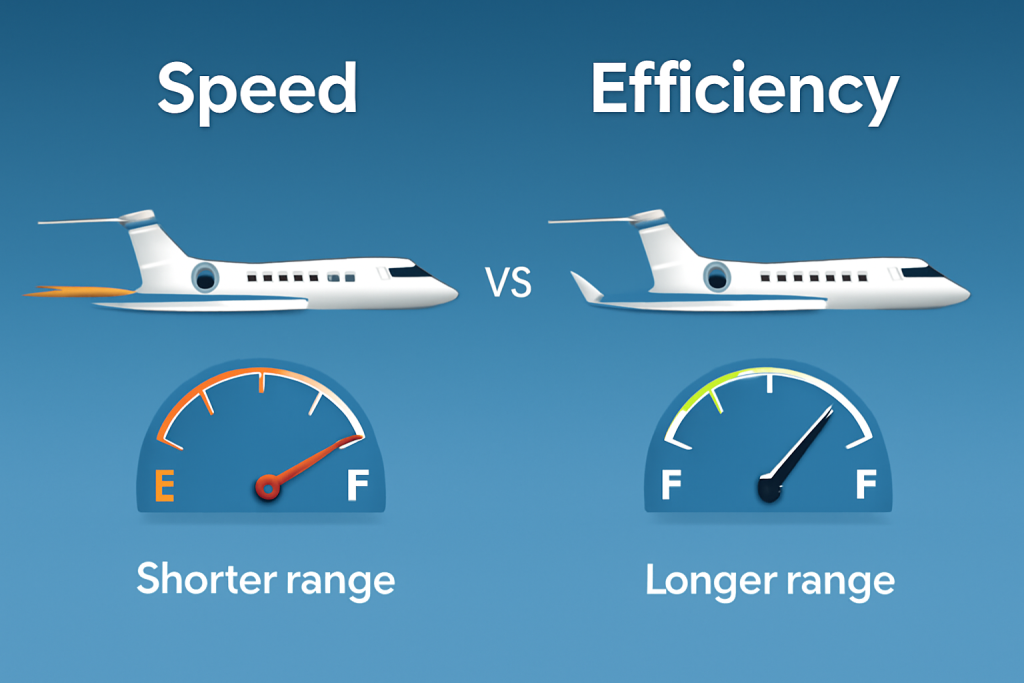
The truth is, most private jets rarely fly at their maximum advertised speeds. And there’s a good reason for that.
Performance vs. Practicality
While jets like the Citation X+ can reach Mach 0.935, they often cruise closer to Mach 0.88 to 0.90 on a typical mission. Why? Because flying at top speed increases fuel burn, operational costs, and wear on components.
High speed may shave off 20–30 minutes, but it could also increase fuel usage by 10–20%. For owners and operators managing a fleet or watching margins, that tradeoff isn’t always worthwhile.
Fuel Efficiency Matters More Than You Think
Especially on longer flights, jets are optimized to cruise at efficient altitudes and speeds. A Gulfstream G700, for instance, performs best at high altitudes (up to 51,000 feet) where it can balance speed with range and fuel economy.
In many cases, a jet may cruise slightly slower than max Mach to extend range or conserve fuel for weather deviations or holding patterns.
Time Isn’t Always Linear in Private Aviation
It’s important to remember that private jet travel eliminates many ground delays:
- No commercial check-in queues
- No TSA screening
- No boarding wait or gate holds
- Direct point-to-point routing
This means even if your jet is cruising 50 mph slower than its top-end peer, your door-to-door time could still be shorter—because efficiency includes the entire journey, not just airspeed.
Comfort and Safety Over Raw Speed
Jet owners value smooth rides, quiet cabins, and reliability just as much as performance specs. Cruising slightly below maximum speed reduces turbulence impact, engine strain, and passenger fatigue—especially on ultra-long flights.
And let’s not forget that corporate flight departments and high-net-worth individuals are often more interested in predictability and comfort than posting record run times.
Speed is impressive—and in the right scenarios, it matters greatly. But for most private jet owners, efficiency, reliability, and comfort take precedence. The smartest operators don’t just ask “how fast can we go?” They ask, “what gets us there best?”
That’s the true luxury of private aviation: control. The freedom to fly fast when it matters, and wisely when it counts.
Real-World Travel Scenarios – Speed in Action
Speed in private aviation isn’t just a luxury—it’s leverage. It’s what turns tight schedules into seamless journeys and critical situations into controlled outcomes. These real-world examples show how the speed of a private jet makes the difference when time truly matters.
Executive on a Mission – L.A. to Tokyo
A tech CEO needs to attend a board meeting and product launch in Tokyo. Using a Bombardier Global 7500, the nonstop flight from Los Angeles to Tokyo takes just 11.5 hours. There’s no layover, no commercial delay, and the aircraft departs from a private terminal.
Why speed matters: Time saved becomes capital gained, and strategic presence is preserved.
Medical Evacuation – Paris to Cairo
A cardiac emergency calls for immediate evacuation from Cairo to Paris—handled by one of the best air ambulance services available. A Challenger 350, configured for medical response, is airborne within 90 minutes and reaches its destination in under four hours—faster than any commercial route.
Why speed matters: In life-threatening situations, minutes—not hours—make the difference.
Last-Minute Family Getaway – London to Ibiza
On a Friday afternoon, a family of six decides to spend the weekend in Ibiza. Instead of dealing with sold-out commercial flights and airport stress, they board a Phenom 300E within hours of the call. The direct flight lands just in time for sunset.
Why speed matters: The spontaneous trip is only possible because of on-demand, high-speed private flight.
Business Advantage – Geneva to Dubai
Two companies are competing for a billion-dollar infrastructure contract. One CEO flies commercial; the other takes a Gulfstream G700, arriving a day earlier. Well-rested, better prepared, and first in the room.
Why speed matters: Showing up early helped shape the negotiation—and close the deal.
Ultra-Efficient Executive Travel – Mumbai to Singapore
A senior executive from a multinational firm based in Mumbai needs to attend a strategic merger discussion in Singapore. A Dassault Falcon 2000LXS is ready at Mumbai’s private terminal and departs within two hours. The jet cruises at 470 knots and lands in Singapore in under 5.5 hours—nonstop.
Why speed matters: The executive attends the meeting and returns the same day, avoiding a full day of lost productivity.
The Common Thread: Speed Creates Opportunity
From corporate strategy and emergency medicine to family spontaneity, speed in private aviation isn’t about chasing records—it’s about creating access. It enables people to be where they need to be, when it matters most, with time to spare.
How Private Jet Speed Compares to Commercial Airlines
Private jets and commercial airliners often cruise at similar speeds, which surprises many first-time flyers. But the real value of private aviation isn’t just in how fast a jet moves through the sky—it’s in how efficiently it moves you through the entire journey.
Cruise Speeds: Closer Than You Think
Most modern commercial airliners cruise between 460 and 560 miles per hour (mph).
Private jets, depending on the class, typically cruise between 460 and 600 mph, with high-performance models like the Gulfstream G700 or Citation X+ pushing beyond that.
So yes—many private jets fly just as fast, or faster, than commercial aircraft.
But It’s Not Just About Cruise Speed
The real edge comes from everything around the flight:
- No long security lines
- No airport delays or layovers
- Departure from smaller, closer airports
- Custom routes with fewer detours or holding patterns
- Faster taxi times, direct runway access, immediate boarding
In many cases, a private jet traveling 50 mph slower than a commercial flight still arrives earlier, simply because the trip is streamlined end-to-end.
Door-to-Door Time is What Counts
Let’s compare a real route:
Mumbai to Dubai – Commercial vs. Private
Commercial:
- Check-in + immigration: 2–2.5 hours
- Flight time: ~3 hours
- Taxiing + disembarkation: 30–45 minutes
- Total time: ~6–6.5 hours
Private Jet (e.g., Falcon 2000 or G280):
- Terminal to takeoff: 20–30 minutes
- Flight time: ~2.75 hours
- Direct transfer on arrival: 10 minutes
- Total time: ~3.5 hours
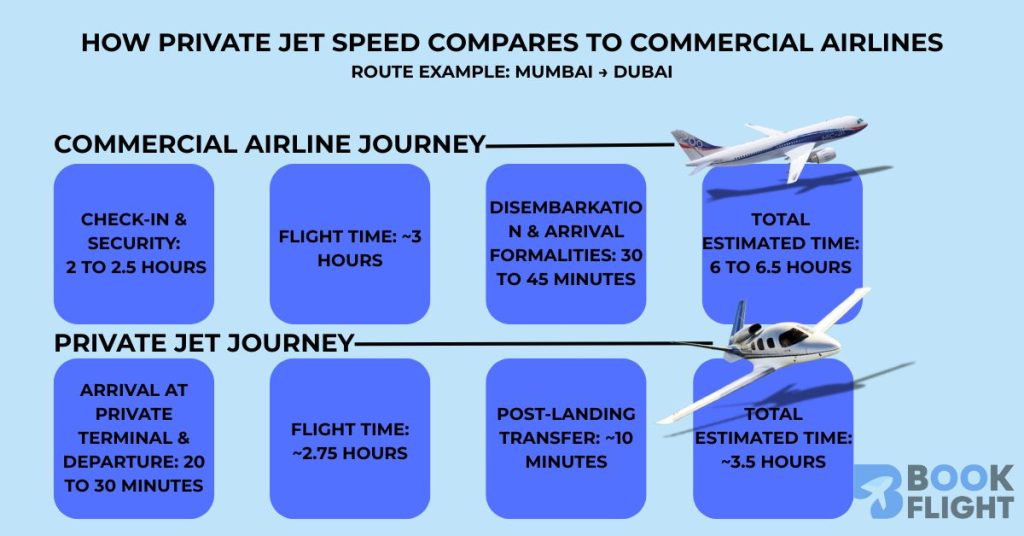
Efficiency Over Raw Speed
Commercial airlines are optimized for volume. Private jets are optimized for flexibility and responsiveness. Even when flying at the same airspeed, private aviation wins the time game by cutting out wasted hours before and after the flight.
It’s not just the speed of the jet. It’s the speed of the experience.
The Future of Private Jet Speed – Supersonic Possibilities
Today’s fastest private jets already flirt with the sound barrier. But what comes next? Could we see a return to supersonic travel, this time in the world of private aviation?
The answer: possibly—but not without challenges.
What Is Supersonic Flight?
Supersonic means traveling faster than the speed of sound—above Mach 1, or approximately 767 mph at sea level.
The legendary Concorde once flew at Mach 2.04, carrying passengers from New York to London in under 3.5 hours. But it was retired in 2003 due to high costs, limited routes, and noise regulations.
The Supersonic Comeback
Several companies are now racing to revive supersonic travel—this time, built around private and business jet needs. These include:
1. Boom Supersonic – Overture
- Top Speed Goal: Mach 1.7
- Range: ~4,250 nautical miles
- Seats: Up to 64 (though private configurations may follow)
- Timeline: First flights targeted for late 2020s
2. Exosonic
- Focused on low-boom supersonic tech, potentially usable over land
- Partnering with the U.S. Air Force and targeting government and executive use
3. Spike Aerospace – S-512
- Design: Quiet supersonic business jet
- Speed: Mach 1.6 (proposed)
- Passenger capacity: 12–18
- Aimed at private jet owners and charter fleets
The Obstacles
Despite excitement, significant barriers remain:
- Sonic booms: Loud shockwaves that restrict supersonic flight over populated areas
- Environmental pressure: Supersonic aircraft burn more fuel and emit more CO₂
- Regulatory delays: FAA and global aviation bodies must approve new flight corridors
- Operating costs: These jets will be extremely expensive to fly and maintain
Why Private Aviation Is Leading the Charge
Unlike commercial airlines, private jets don’t need to fill hundreds of seats to break even. Owners and charter clients are willing to pay for time saved. This economic model makes business aviation the most viable segment for supersonic re-entry.
Will We See It Soon?
Realistically, you won’t be flying supersonic privately before 2030—but by the 2030s, we could see:
- 2–3 hour flights between major international cities
- High-speed air taxis on transcontinental routes
- Next-gen hybrid aircraft with both subsonic and supersonic cruise modes
The future of jet speed isn’t just about going faster. It’s about going smarter, cleaner, and farther—and maybe, someday soon, faster than sound.
Private aviation will likely be the first to cross that next great threshold. And when it does, it will redefine global connectivity—again.
Conclusion – More Than Just Speed
When people ask, “How fast do private jets fly?”, they’re usually expecting a number—something they can compare or be impressed by. But the deeper truth behind that question is far more meaningful.
Yes, private jets are fast. Many fly at 500 to 600 mph, with the fastest pushing Mach 0.935. But speed in business aviation is about more than physics—it’s about freedom.
It’s the freedom to depart when you want.
The freedom to skip delays.
The freedom to be across the world tonight—and home for breakfast tomorrow.
For business leaders, it’s a tool for leverage. For families, it’s a vehicle for time together. For emergency teams, it’s a literal lifesaver. In every case, the value of private aviation is measured less in miles per hour—and more in moments made possible.
And as we look ahead to the next generation of aircraft—possibly supersonic—the definition of “fast” may evolve again. But one thing won’t change: speed will continue to be a means to an end, not the end itself.
In the world of private jets, speed is power—but control, flexibility, and access? That’s true luxury.
We’d Love to Hear From You
What surprised you the most about private jet speeds?
Do you have a real-life story or question about private flying?
Share your thoughts or ask us anything in the comments below—we’re here to help you fly smarter, faster, and with more freedom than ever.
